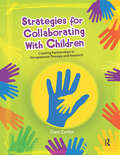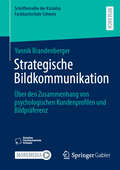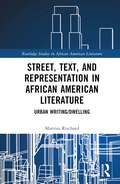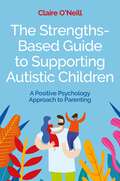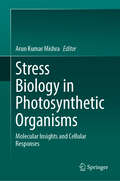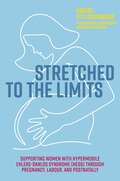- Table View
- List View
Strategies for Child Welfare Professionals Working with Transgender and Gender Expansive Youth
by Gerald MallonExpert guidance for child welfare and youth care professionals looking to increase their knowledge about, and skills in, working with transgender and gender expansive youth and their families. Many professionals working in child welfare and youth service (including line workers, supervisors, managers, and administrators), lack adequate knowledge about trans or gender expansive identities, which means they are not sufficiently prepared to address or respond to the needs of trans or gender expansive youth. This guide will provide readers with the information they need to do their jobs effectively with youth of all genders, including guidance on relationships, discrimination, mental health, foster care and homelessness. It provides examples of successful practice in a variety of case narratives from youth and their families.
Strategies for Collaborating With Children: Creating Partnerships in Occupational Therapy and Research
by Clare CurtinStrategies for Collaborating With Children: Creating Partnerships in Occupational Therapy and Research applies client-centered and strengths-based theories to pediatric practice. The text is organized using a research-based conceptual model of collaboration. Within this text, there are detailed descriptions of how to engage and work with children aged 3 to 12 years, from the beginning to the end of therapy.Dr. Clare Curtin covers a variety of topics, such as how to interview children, involve them in defining the purpose of therapy, and develop self-advocacy. Similarly presented is the therapist’s role as a guide in setting respectful limits, teaching self-regulation, avoiding power struggles, and co-creating educational experiences that are challenging and fun. Strategies for Collaborating With Children: Creating Partnerships in Occupational Therapy and Research advocates for children's rights and participation in therapy and research. The United Nations Convention on the Rights of the Child, the new sociology of childhood, and childhood studies are discussed. Also included are children's perspectives on what therapists should know and what children said they might be thinking at each stage of therapy. The last chapter focuses on methods to enhance children’s participation in research, including adaptations for children with disabilities.Unique features: Describes a new research-based model of collaboration with children Incorporates children’s views and knowledge about therapy Illustrates the use of client-centered and strengths-based theories as well as child-friendly approaches within pediatric practice Provides over 1,600 practical strategies that are exemplified by stories with actual dialogue Describes ways to involve children throughout the research process Identifies verbal, visual, and activity-based participatory research methods for eliciting children's voices, including creative ways to involve children with different levels of abilities Includes review questions at the end of each chapter Included with the text are online supplemental materials for faculty use in the classroom.Strategies for Collaborating With Children: Creating Partnerships in Occupational Therapy and Research delivers a comprehensive resource for collaborating with children for the occupational therapist, occupational therapy assistant, or any other practitioner working with children in a therapeutic setting.
Strategies for Collaborating With Children: Creating Partnerships in Occupational Therapy and Research
by Clare CurtinStrategies for Collaborating With Children: Creating Partnerships in Occupational Therapy and Research applies client-centered and strengths-based theories to pediatric practice. The text is organized using a research-based conceptual model of collaboration. Within this text, there are detailed descriptions of how to engage and work with children aged 3 to 12 years, from the beginning to the end of therapy.Dr. Clare Curtin covers a variety of topics, such as how to interview children, involve them in defining the purpose of therapy, and develop self-advocacy. Similarly presented is the therapist’s role as a guide in setting respectful limits, teaching self-regulation, avoiding power struggles, and co-creating educational experiences that are challenging and fun. Strategies for Collaborating With Children: Creating Partnerships in Occupational Therapy and Research advocates for children's rights and participation in therapy and research. The United Nations Convention on the Rights of the Child, the new sociology of childhood, and childhood studies are discussed. Also included are children's perspectives on what therapists should know and what children said they might be thinking at each stage of therapy. The last chapter focuses on methods to enhance children’s participation in research, including adaptations for children with disabilities.Unique features: Describes a new research-based model of collaboration with children Incorporates children’s views and knowledge about therapy Illustrates the use of client-centered and strengths-based theories as well as child-friendly approaches within pediatric practice Provides over 1,600 practical strategies that are exemplified by stories with actual dialogue Describes ways to involve children throughout the research process Identifies verbal, visual, and activity-based participatory research methods for eliciting children's voices, including creative ways to involve children with different levels of abilities Includes review questions at the end of each chapter Included with the text are online supplemental materials for faculty use in the classroom.Strategies for Collaborating With Children: Creating Partnerships in Occupational Therapy and Research delivers a comprehensive resource for collaborating with children for the occupational therapist, occupational therapy assistant, or any other practitioner working with children in a therapeutic setting.
Strategies Of Qualitative Inquiry
by Norman K. Denzin Yvonna S. LincolnStrategies of Qualitative Inquiry, Fourth Edition is Volume II of the three-volume paperback versions of The SAGE Handbook of Qualitative Research, Fourth Edition. This portion of the handbook consists of the topics addressed in "Part III: Strategies of Inquiry." Strategies of Qualitative Inquiry, Fourth Edition isolates the major strategies-historically, the research methods-that researchers can use in conducting concrete qualitative studies. The question of methods begins with questions of design and the matters of money and funding. These questions always begin with the researcher who moves from a research question to a paradigm or perspective, and then to the empirical world. The history and uses of these strategies are explored extensively in this volume. The chapters move from forms (and problems with) mixed methods inquiry to case study, performance and narrative ethnography, to constructionist analytics to grounded theory strategies, testimonies, participatory action research, and clinical research.
Strategische Bildkommunikation: Über den Zusammenhang von psychologischen Kundenprofilen und Bildpräferenz (Schriftenreihe der Kalaidos Fachhochschule Schweiz)
by Yannik BrandenbergerIn einer sich rasant verändernden Marketinglandschaft wird die Bedeutung einer authentischen Verbindung zwischen Unternehmen und Konsumenten immer dringlicher. Statt mit Inhalten zu überfluten, liegt die Herausforderung darin, durch gezielte visuelle Kommunikation eine tiefere Bindung aufzubauen. Diese Herausforderung wird besonders in der fehlenden Anpassung von Bildern an die psychologischen Profile der Zielgruppe deutlich, für die bisher kein empirisch validiertes Modell existiert. In diesem Buch wird ein tiefer Einblick in den Zusammenhang zwischen psychologischen Kundenprofilen und Bildpräferenzen durch die Untersuchung und Weiterentwicklung des EIC-Modells gewonnen. Die empirischen Ergebnisse, gewonnen aus einer Studie mit 95 Teilnehmenden, bestätigen diese Verbindung und eröffnen neue Perspektiven für die strategische Bildkommunikation. Als Resultat dieser Forschung präsentiert sich das ICS-Modell – ein Instrument, das Fotograf*innen und Marketingexpert*innen befähigt, die Bildkommunikation gezielt auf Zielgruppen auszurichten. Dieses Buch bietet nicht nur einen Einblick in die theoretischen Grundlagen, es regt auch dazu an, wie diese Erkenntnisse in der Praxis für eine wirkungsvolle visuelle Kommunikation genutzt werden können.
Strategizing With Institutional Theory (Elements in Business Strategy)
by null Harry SminiaThis text consults seven variants of institutional theory to explore how these can be applied to strategic management. These variants are New Institutional Economics, Old Institutionalism, New Institutionalism, institutional entrepreneurship and change, intra organizational institutionalization, institutional logics, and institutional work. In doing so, three strategic management styles are distinguished: competitiveness based strategic management, legitimacy based strategic management, and performativity based strategic management. While the competitive based style sees institutional theory submitting to mainstream strategy research, offering additional variables and considerations to explain competitive advantage, the legitimacy based style makes institutional theory a strategy theory in its own right by providing an explanation for an organization's viability that emphasizes legitimacy over competitive advantage. The performativity based style is an even more radical departure from mainstream strategizing by purporting that a future is actively created with organizations making contributions as emerging issues are being dealt with.
Strategy as Practice: An Activity Based Approach (SAGE Strategy series)
by Paula Jarzabkowski`An important and extremely welcome addition to the strategic management field. In this book the author builds on the work of an emerging community of scholars to lay out theoretical and methodological underpinnings of an activity-based framework for applying the practice lens to strategy′ - Academy of Management Review `Paula Jarzabkowski has astutely signaled an agenda for future scholarship that will no doubt fuel the continued growth of this subfield′ - Organization Studies `Pioneering work. As the first book in the new strategy-as-practice field, it offers readers both innovative models and exemplary field research′ - Richard Whittington, Professor of Strategic Management, Said Business School, Oxford ′Extends and develops the emerging fields of strategy and practice as well as activity theory. It also demonstrates empirically, using University settings, how activity theory is itself bounded by the wider contexts of organisation, embedded routines and the heavy hand of history′ - David C. Wilson, University of Warwick `An insightful book that would be of use to people interested in the actual practices of strategy and strategizing′ - Organization Bridging the gap between what managers actually do and organizational strategies, this book provides an activity-based framework for studying strategy as practice, with empirical evidence to illustrate the dynamics of this framework in real terms.
Street, Text, and Representation in African American Literature: Urban Writing/Dwelling (Routledge Studies in African American Literature)
by Mattius RischardComprehensive and comparative, this volume investigates African American street novelists since the Chicago Black Renaissance and the semiotic strategies they employ in publication, consumption, and depiction of street life. Divided into three chapters, this text analyzes the content, style, and ethics of “street” narrative through a discursive/rhetorical lens, exploring the development of street literature’s formal and contextual concerns to resolve the sociocultural and political questions surrounding cultural work. The book also gives emphasis to “text” or (post)structural literary analysis by answering questions about the genre’s aesthetic and linguistic techniques that respond to the injustices of urban planning. The last chapter, “Representation,” investigates the phenomenological hermeneutics of more recent street literature and its satire, highlighting the political stakes for authorship, credibility, and subjectivity. Through historical and contemporary studies of urban space, Blackness, and adaptations of street literature, this work attempts to network activists, artists, and scholars with the greater reading public by providing a functional ontology of reading the inner city.
Street, Text, and Representation in African American Literature: Urban Writing/Dwelling (Routledge Studies in African American Literature)
by Mattius RischardComprehensive and comparative, this volume investigates African American street novelists since the Chicago Black Renaissance and the semiotic strategies they employ in publication, consumption, and depiction of street life. Divided into three chapters, this text analyzes the content, style, and ethics of “street” narrative through a discursive/rhetorical lens, exploring the development of street literature’s formal and contextual concerns to resolve the sociocultural and political questions surrounding cultural work. The book also gives emphasis to “text” or (post)structural literary analysis by answering questions about the genre’s aesthetic and linguistic techniques that respond to the injustices of urban planning. The last chapter, “Representation,” investigates the phenomenological hermeneutics of more recent street literature and its satire, highlighting the political stakes for authorship, credibility, and subjectivity. Through historical and contemporary studies of urban space, Blackness, and adaptations of street literature, this work attempts to network activists, artists, and scholars with the greater reading public by providing a functional ontology of reading the inner city.
Strengthening Campus Communities Through the Truth, Racial Healing, and Transformation Framework
by Tia Brown McNairThis edited volume encourages and informs the transformational steps needed for a better, more equitable future for all. These efforts, being led by higher education institutions, complement existing diversity, equity, and inclusion initiatives and are part of the W. K. Kellogg Foundation’s national Truth, Racial Healing, and Transformation™ effort.The American Association of Colleges and Universities is partnering with higher education institutions to develop TRHT Campus Centers dedicated to erasing barriers to equal treatment and opportunity on campuses, in communities, and throughout the nation at large. The narratives in this book include case study essay contributions from current TRHT Campus Centers that offer practical examples for translating the TRHT Framework into replicable strategies to inform constructive change. Contributions are drawn from a breadth of institution types including community colleges, liberal arts colleges, HBCUs, minority-serving institutions, faith-based institutions, regional comprehensives, and large research universities.Timely, powerful, and well-supplied with practical strategies, this book is an ideal guide for any college educator interested in diversity, equity, inclusion, and belonging; student leadership development; and models for institutional, structural, and systemic change.
Strengthening Campus Communities Through the Truth, Racial Healing, and Transformation Framework
by Tia Brown McNairThis edited volume encourages and informs the transformational steps needed for a better, more equitable future for all. These efforts, being led by higher education institutions, complement existing diversity, equity, and inclusion initiatives and are part of the W. K. Kellogg Foundation’s national Truth, Racial Healing, and Transformation™ effort.The American Association of Colleges and Universities is partnering with higher education institutions to develop TRHT Campus Centers dedicated to erasing barriers to equal treatment and opportunity on campuses, in communities, and throughout the nation at large. The narratives in this book include case study essay contributions from current TRHT Campus Centers that offer practical examples for translating the TRHT Framework into replicable strategies to inform constructive change. Contributions are drawn from a breadth of institution types including community colleges, liberal arts colleges, HBCUs, minority-serving institutions, faith-based institutions, regional comprehensives, and large research universities.Timely, powerful, and well-supplied with practical strategies, this book is an ideal guide for any college educator interested in diversity, equity, inclusion, and belonging; student leadership development; and models for institutional, structural, and systemic change.
Strengthening Emotional Ties through Parent-Child-Dyad Art Therapy: Interventions with Infants and Preschoolers
by Lucille ProulxProulx explores many aspects of dyad art therapy including attachment relationship theories, roles in dyad interventions, the importance of the tactile experience and ways in which dyad art therapy can be used. This original book will be invaluable to mental health professionals and to parents wishing to enrich interactions with their children.
The Strengths-Based Guide to Supporting Autistic Children: A Positive Psychology Approach to Parenting
by Claire O'Neill'Being strength-aware has brought many moments of joy to our family life. It is this potential for growth and joy that I now want to share in this book'This flexible, dip-in-dip-out guide will introduce you to the strengths-based approach that is helping autistic children and their families to thrive. By focusing on how to identify, develop and use your child's strengths to support them throughout childhood and into adolescence, this transformative approach is here to show you and your child that their unique character-strengths can empower them and shape their future.Claire O'Neill combines her personal experience as an autistic person and mother to autistic children with her expert knowledge as a professional working with autistic young people to demonstrate the value of a strengths-based approach.With step-by-step instructions on how parents and teachers can incorporate this approach easily into family and school life, Claire also offers a variety of specific tips, tricks and engaging activities to provide ongoing support for parents and teachers alike.
Streptococcus suis: Methods and Protocols (Methods in Molecular Biology #2815)
by Jesús Arenas BustoThis volume covers the classic and new techniques used to study the zoonotic pathogen Streptococcus suis. The chapters in this book cover are organized in four sections and cover topics such as techniques for cultivation, isolation, typing of S. suis biofilm formation and genetic manipulation; analysis of antibiotic resistance and transference; detection in pigs and infection models; and evaluation of economic impact and prevention. Written in the highly successful Methods in Molecular Biology series format, chapters include introductions to their respective topics, lists of the necessary materials and reagents, step-by-step, readily reproducible laboratory protocols, and tips on troubleshooting and avoiding known pitfalls. Comprehensive and thorough, Streptococcus suis: Methods and Protocols is a valuable resource for both novel and expert researchers who want to expand their knowledge of this important field.
Stress Biology in Photosynthetic Organisms: Molecular Insights and Cellular Responses
by Arun Kumar MishraThis book explores the intricate mechanisms underlying the stress responses of phototrophs, which play a critical and foundational role in shaping and sustaining life on Earth.The photoautotrophic entities encounter a spectrum of natural and anthropogenic stresses, inducing a multitude of responses at the physiological, biochemical, genetic, and developmental levels. The comprehension of how these phototrophs adeptly counter stressors transcends mere scientific pursuit; it stands as an essential endeavor for predicting their adaptability in an ever-evolving world and, crucially, for conserving our delicate ecosystems. The book will shed light on the sophisticated interplay of stress signaling pathways and the nuanced engagement of stress-responsive hormones within these life forms. Furthermore, it unveils the cryptic genetic and epigenetic controls dictating stress-related gene expression, yielding profound insights into the enduring recollection of their responses to environmental challenges.This book is an essential read for researchers, educators, and students alike. It offers a comprehensive panorama of stress biology, unveiling the innermost mechanisms at play within photosynthetic organisms discussing their resilience and adaptation.
Stretched to the Limits: Supporting Women with Hypermobile Ehlers-Danlos Syndrome (hEDS) Through Pregnancy, Labour, and Postnatally
by Rachel Fitz-DesorgherOur increased knowledge and appreciation of hypermobile Ehlers-Danlos syndrome (hEDS) has been making headlines across medical research and practice. Stretched to the Limits is the first text to apply this new understanding directly to midwifery. The book details the effects of hEDS on the different bodily systems, and the implications for pregnancy, labour, birth and postnatally. Midwives and doulas are likely, at some point in their careers, to come across women with this most common sub-type. hEDS affects at least 1 in 5,000 women but they frequently find themselves on a care pathway more suitable for those with other, rarer, subtypes such as classic EDS (cEDS) or vascular EDS (vEDS). Additionally, much of the advice detailed here will also help to support the 20% of the population with more generalised hypermobility. This book is, therefore, essential reading for empowering midwives and doulas to feel confident in their understanding of hEDS, so that they can best inform and support their clients and colleagues with the most appropriate care. It will also provide a valuable resource for those with hEDS to share with their care team and advocate for their needs when planning pregnancy and birth.
Stroke Survivor: A Personal Guide to Recovery
by Andy McCannThe book explores a broad range of issues experienced by stroke survivors, from the very practical considerations of managing financial security and understanding medical approaches and terminology to the more personal challenges of coming to terms with a new sense of vulnerability and dealing with the attitudes of friends and family.
Structural Design of Buildings: Fundamentals in Design, Management and Sustainability
by Feng Fu and David RichardsonStructural Design of Buildings: Fundamentals in Design, Management and Sustainability is the essential reference for all structural engineers involved in the design of buildings and other structures. The book forms part of the Structural Design of Buildings series and takes a project-oriented approach, covering key issues that design professionals face at the outset of a project such as structural design processes, managing risk, loadings, sustainability, and computational design. Broken down into the key areas for understanding and undertaking structural design and with a fully international approach, this book features coverage of design considerations sustainability in the built environment BIM Risk management different types of loadings finite element computational design materials science concrete technology. The book contains information on collaboration with other professionals, design objectives, leadership in design, use of software and a sustainable approach to design. It is a timely and essential read for consultants, designers, technicians and contractors tasked with structural design of buildings.
Structural Design of Buildings: Fundamentals in Design, Management and Sustainability
by David Richardson Feng FuStructural Design of Buildings: Fundamentals in Design, Management and Sustainability is the essential reference for all structural engineers involved in the design of buildings and other structures. The book forms part of the Structural Design of Buildings series and takes a project-oriented approach, covering key issues that design professionals face at the outset of a project such as structural design processes, managing risk, loadings, sustainability, and computational design. Broken down into the key areas for understanding and undertaking structural design and with a fully international approach, this book features coverage of design considerations sustainability in the built environment BIM Risk management different types of loadings finite element computational design materials science concrete technology. The book contains information on collaboration with other professionals, design objectives, leadership in design, use of software and a sustainable approach to design. It is a timely and essential read for consultants, designers, technicians and contractors tasked with structural design of buildings.
Structural Dynamics
by Einar N. StrømmenThe first part of this book covers the general theory of structural dynamics, in a calculous format as well as a finite element formulation. Secondly, it contains methods of eigenvalue calculations of civil engineering structural systems. And third, it contains a major part covering dynamic displacement response calculations as induced by earthquake, turbulent wind, vortex shedding and moving vehicles, enabling the designer to evaluate structural safety from the effects of fluctuating internal forces.The general theory contains comprehensive development of the principle of virtual displacements, as well as the Galerkin solution to eigenvalue problems. A separate chapter has been dedicated to the suspension bridge. The theory of single or multiple tuned mass dampers is included, a theory not presented elsewhere.The book contains a chapter covering the theory of structural damping, as well as comprehensive data of the structural damping properties that are necessary forany dynamic response calculation. The book is intended for students as well as practising engineers. It contains numerous relevant examples, covering numerical solutions that are well suited for computer programming.
Structural Information and Communication Complexity: 31st International Colloquium, SIROCCO 2024, Vietri sul Mare, Italy, May 27–29, 2024, Proceedings (Lecture Notes in Computer Science #14662)
by Yuval EmekThis book constitutes the refereed proceedings of the 31th International Colloquium on Structural Information and Communication Complexity, SIROCCO 2024, held in Haifa, Israel in May 2024. The 24 full papers and 6 short papers presented in this book were carefully reviewed and selected from 49 submissions. SIROCCO is devoted to the study of the interplay between structural knowledge, communication, and computing in decentralized systems of multiple communicating entities. Special emphasis is given to innovative approaches leading to better understanding of the relationship between computing and communication.
Structural System Analysis: Su-Field Analysis. TRIZ
by Vladimir PetrovThis book provides a comprehensive exploration of SU-Field Analysis, a groundbreaking framework that delves into the intricate realms of fields, substances, and interactions. It commences with an introduction to the fundamental concepts (Chapter 1), followed by an elucidation of the basic configurations (Chapter 2) and an in-depth examination of various SU-Field systems (Chapter 3). Within Chapter 3, the text delves into the SU-Field model for fields, types of SU-Field systems for measurement and detection, and various SU-Field models. Subsequently, the book delves into the critical subject of eliminating harmful interactions (Chapter 4), discussing trends, introducing innovative solutions like S3, and exploring the use of substances and fields to decelerate detrimental effects. In Chapter 5, the focus shifts to finding desired effects, while Chapter 6 unveils the Law of Increasing Degree of SU-Field, elucidating its general trends and the forcing of substances and fields. Further insights into this law are presented in Chapter 6.4. Additionally, the book touches upon SU-Field Analysis in the context of information systems (Chapter 7) and introduces a new SU-Field structure (Chapter 8). The latter includes discussions on general concepts, parametric analysis, patterns of control elements, energy and information control, knowledge development, and structural analysis of information processing systems. Throughout, the book offers readers a comprehensive and detailed understanding of SU-Field Analysis, making it an invaluable resource for those seeking to explore this groundbreaking field.
The Structure of Ideas: Mapping a New Theory of Free Expression in the AI Era
by Jared SchroederIn his historic 1919 dissent, Justice Oliver Wendell Holmes named, and thus catalyzed the creation of, the marketplace of ideas. This conceptual space has, ever since, been used to give shape to American constitutional notions of the freedom of expression. It has also eluded clear definition, as jurists and scholars have contested its meaning for more than a century. In The Structure of Ideas, Jared Schroeder takes on the task of mapping the various iterations of the marketplace, from its early foundations in Enlightenment beliefs in universal truths and rational actors, to its increasingly expansive parameters for protecting expression in the arenas of commercial, corporate, and online speech. Schroeder contends that in today's information landscape, marked by the rapid emergence of artificial intelligence, the marketplace is failing to provide a space where truths succeed and falsity fails. AI and networked technologies have thoroughly overpowered all traditional pictures of the marketplace up to now. Schroeder proposes various theoretical interventions that would revise the marketplace for the current moment, and concludes by describing a new space built around algorithms, AI, and virtual communication.
The Structure of Ideas: Mapping a New Theory of Free Expression in the AI Era
by Jared SchroederIn his historic 1919 dissent, Justice Oliver Wendell Holmes named, and thus catalyzed the creation of, the marketplace of ideas. This conceptual space has, ever since, been used to give shape to American constitutional notions of the freedom of expression. It has also eluded clear definition, as jurists and scholars have contested its meaning for more than a century. In The Structure of Ideas, Jared Schroeder takes on the task of mapping the various iterations of the marketplace, from its early foundations in Enlightenment beliefs in universal truths and rational actors, to its increasingly expansive parameters for protecting expression in the arenas of commercial, corporate, and online speech. Schroeder contends that in today's information landscape, marked by the rapid emergence of artificial intelligence, the marketplace is failing to provide a space where truths succeed and falsity fails. AI and networked technologies have thoroughly overpowered all traditional pictures of the marketplace up to now. Schroeder proposes various theoretical interventions that would revise the marketplace for the current moment, and concludes by describing a new space built around algorithms, AI, and virtual communication.

